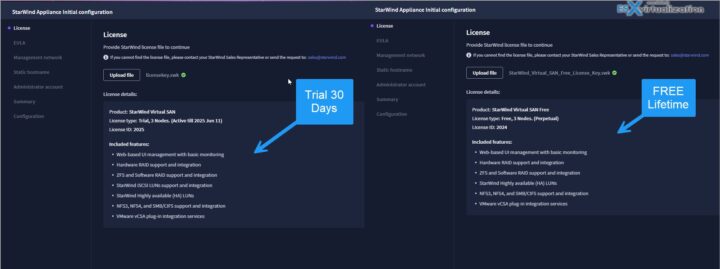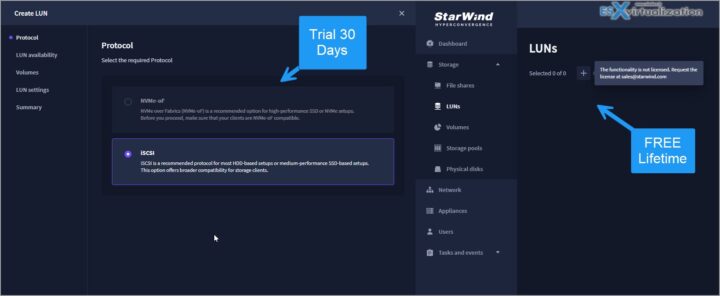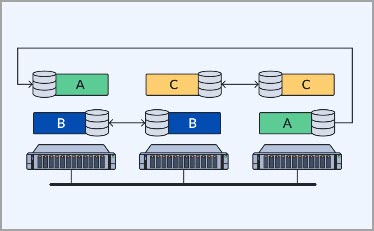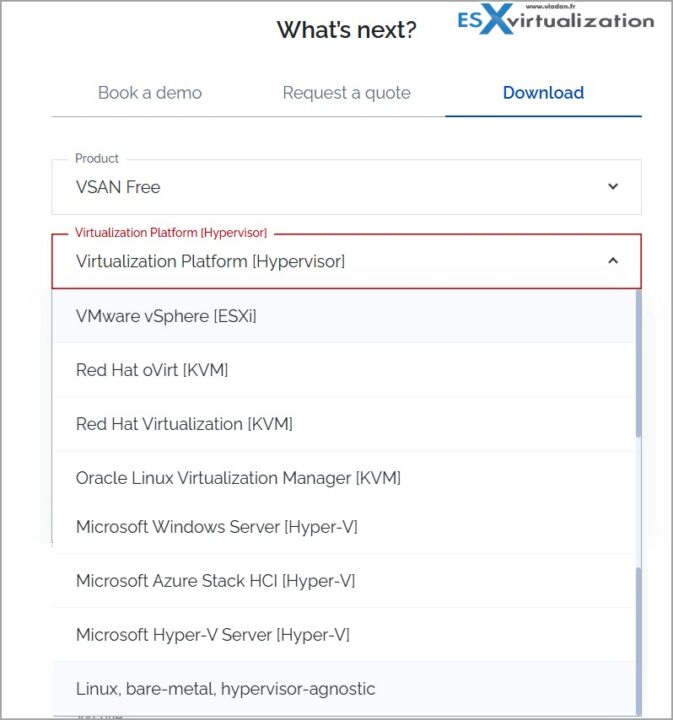StarWind software has a free version of their product VSAN. This is not new. However, many people ignore that the free version is not the same as the trial version (30 days trial). In this post we'll point out some of the differences between the Trial version of StarWind VSAN and the Lifetime FREE version.
The lifetime FREE version can be used in production and there is no capacity limit. You have to deploy it by yourself and use it only with community support.
From StarWind's email:
Your license to the software is perpetual and NOT time-bombed. Production use IS permitted. However, there are certain restrictions in functionality (Web UI, ZFS, NVMe-oF, etc.) and support, including the initial deployment and evaluation period. That’s why if you plan to use VSAN in the commercial environment, it’s strongly recommended to apply for the trial version. In other words: Do NOT use the free version as a trial! They are different!
The standard full version has a trial that has all functions available during 30 days trial period. I downloaded the FREE version, and also I downloaded the Trial version. And as you can see, there is not that much difference.
Here is the differences:
And when you starting to configure the FREE version, you'll hit its limits when willing to create a new iSCSI LUN….
Here is again the screenshot comparing the trial and the FREE lifetime licenses of the StarWind product.
When you go to the StarWind website, there is also a nice compare table – StarWind FREE vs Paid.
If you're looking for a full Step-by-step procedure on configuring the appliance, just check out this page at StarWind – StarWind Virtual SAN: Configuration Guide for VMware vSphere [ESXi], StarWind Deployed as a Controller VM using PowerShell CLI.
The free version for KVM has actually a no limitations at all (except support).
Quote from StarWind page here:
If you’re happy with the fact that there are certain functionality limitations or even no limitations when it comes to the Linux KVM version… as long as you’re fine doing everything in a self-supported mode. We encourage you to give Virtual SAN (VSAN) Free a try!
StarWind can be installed on 2 nodes minimum, but you can add more nodes for hyperconvergence. Here is a small visual example for 3 nodes:
New modern Web UI
For a while now, StarWind has a completely new UI. We have blogged about it since several our articles.
Quote:
It is a user-friendly web-based management interface that makes handling and keeping an eye on your software-defined storage a breeze. In-built right into the StarWind Virtual SAN Controller Virtual Machine (CVM), this web interface lets you tweak and track every part of your high-availability storage setup – from rounding up drives for a RAID array to whipping up HA volumes and even rolling out the native SMB/NFS file shares.
StarWind’s web-based management interface isn’t just about functionality; it also boasts a sleek and attractive design. This makes managing your storage resources not only efficient but also a visually pleasing experience, providing intuitive interface that’s easy on the eyes.
All it takes is an internet connection and any device – whether it’s a PC or your smartphone – and you’ve got the power to manage your IT infrastructure’s storage from anywhere on the planet.
StarWind Platform Compatibility
As I mostly blogged about VMware or Hyper-V on this blog, it is not completely fair not to mention other platforms. And StarWind rocks. Just look at all those supported solutions.
Trial Download here.
More posts about StarWind on ESX Virtualization:
- Installation of StarWind VSAN Plugin for vSphere
- StarWind VSAN with new UI and deployment options
- Backup Appliance with NVMe Speed and GRAID – StarWind Backup Appliance
- Exploring StarWind VSAN: High Availability, Cost Savings, and Performance
- StarWind V2V Converter The Cutting-Edge Upgrade: StarWind V2V Converter’s April 2024 Innovations
- What is StarWind Tape Redirector (FREE) and what’s the benefits?
- 5 Easy Steps to be more resilient with Two Hosts only – StarWind VSAN
- How StarWind VSAN solution can save you money and energy in ROBO environments
- 2-Nodes clusters without Witness – StarWind VSAN Heartbeat Failover Strategy
- You can’t extend backup window – Check NVMe Backup Appliance from StarWind
- Replacing Aging Hardware SAN Device by a Software – StarWind VSAN
- StarWind V2V Converter (PV2 Migrator) FREE utility
- Cluster with 2-Nodes only – How about quorum?
- StarWind VSAN Latest update allows faster synchronization with storing synchronization journals on separate storage
- How to Update StarWind VSAN for VMware on Linux- Follow UP
- StarWind SAN & NAS software details for VMware and Hyper-V
- Free StarWind iSCSI accelerator download
- VMware vSphere and HyperConverged 2-Node Scenario from StarWind – Step By Step(Opens in a new browser tab)
- How To Create NVMe-Of Target With StarWind VSAN
- Veeam 3-2-1 Backup Rule Now With Starwind VTL
- StarWind and Highly Available NFS
- StarWind VSAN on 3 ESXi Nodes detailed setup
- VMware VSAN Ready Nodes in StarWind HyperConverged Appliance
More posts from ESX Virtualization:
- VMware ESXi FREE is FREE Again!
- Vulnerability in your VMs – VMware Tools Update
- Two New VMware Certified Professional Certifications for VMware administrators: VCP-VVF and VCP-VCF
- Patching ESXi Without Reboot – ESXi Live Patch – Yes, since ESXi 8.0 U3
- Update ESXi Host to the latest ESXi 8.0U3b without vCenter
- Upgrade your VMware VCSA to the latest VCSA 8 U3b – latest security patches and bug fixes
- VMware vSphere 8.0 U2 Released – ESXi 8.0 U2 and VCSA 8.0 U2 How to update
- What’s the purpose of those 17 virtual hard disks within VMware vCenter Server Appliance (VCSA) 8.0?
- VMware vSphere 8 Update 2 New Upgrade Process for vCenter Server details
- VMware vSAN 8 Update 2 with many enhancements announced during VMware Explore
- What’s New in VMware Virtual Hardware v21 and vSphere 8 Update 2?
- Homelab v 8.0
- vSphere 8.0 Page
- ESXi 7.x to 8.x upgrade scenarios
- VMware vCenter Server 7.03 U3g – Download and patch
- Upgrade VMware ESXi to 7.0 U3 via command line
- VMware vCenter Server 7.0 U3e released – another maintenance release fixing vSphere with Tanzu
- What is The Difference between VMware vSphere, ESXi and vCenter






Great breakdown of the differences between the free and trial versions. Quick question: for small businesses that want to try the free version, how steep is the learning curve for deploying and managing without official support?
If they want to try the free version (which is different download from trial), it depends on several factors. If they have time (support via Online forums only), if they have enough IT resources within their team (to learn new techno), and then, if they have “the nerves” to keep this product without official support on production workloads. As you know, people stay, people live. Someone who configured the solution and its no longer the part of the company will most likely not be able to help with potential issues in case something goes wrong. So I’d highly recommend to buy StarWind support if the solution is kept for production environment.